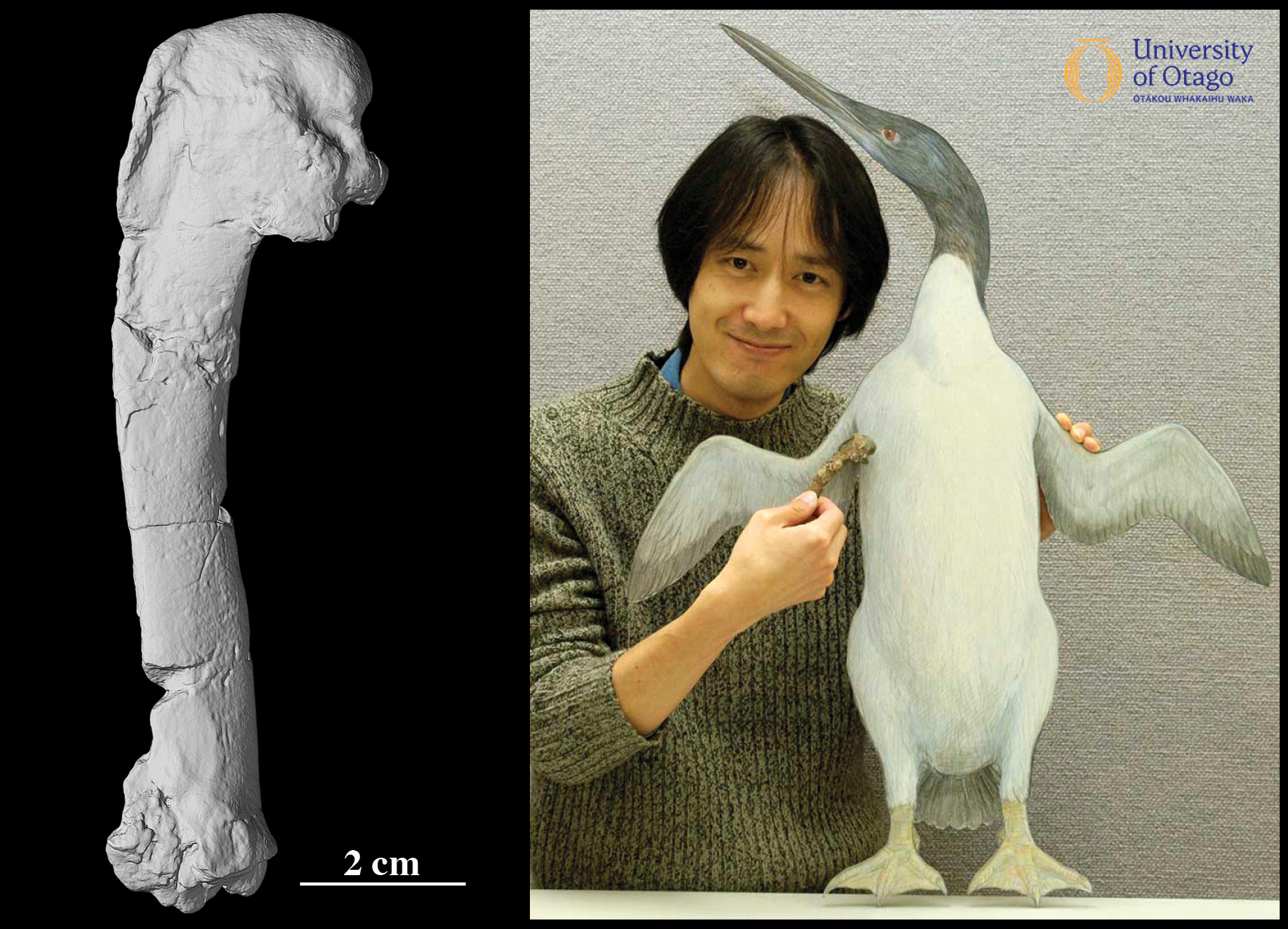16 First penguins from ‘just after’ the big extinction
Aves, Sphenisciformes: Muriwaimanu tuatahi
Penguins are an ancient and charismatic group of birds that are important to marine food webs in many regions across the Southern Hemisphere today. Much has been learned about the origins of penguins by studying fossils from Aotearoa New Zealand. One of the most important milestones in penguin evolutionary research occurred in 2006 when researchers revealed penguin fossils that were around 60–62 million years old. Almost as far back in time as the age of the non-avian dinosaurs.

The left image is a 3D scan of the uppermost wing bone (humerus) from the early penguin Muriwaimanu tuatahi (specimen OU 12651). The right image shows Dr Tatsuro Ando holding the fossil humerus against a reconstruction of Muriwaimanu tuatahi produced by Chris Gaskin. Image credit: RE Fordyce. |
These ancient Muriwaimanu and Waimanu penguins (collectively known as ‘Waipara penguins’) lived in shallow seas off eastern Zealandia during the Paleocene and were about the size of living hoiho (yellow-eyed penguins; around 60 cm tall). Waipara penguins had a more flexible elbow than living penguins, a long spear-like bill, and probably looked a little like a shag (cormorant). Importantly, Waipara penguins had compressed and dense wing bones like living penguins which means that they could use their wings to swim underwater but probably could not fly in air.
Because the Waipara penguins are well dated in terms of geological age it is possible to use that known age to better understand the evolutionary relationships of living birds. If early penguins lived in southern seas not long after the extinction of dinosaurs, then other bird groups more distantly related to penguins must have been established even earlier. Many groups of living birds potentially originated well back in Cretaceous times when dinosaurs were thriving. Thus, Muriwaimanu and Waimanu helped to reveal that many modern lineages of living birds, not just penguins, had ancient origins.
—Written by Daniel B Thomas
| Specimen number: OU 12651 | Age: 62 to 60 million years old (Paleocene, Teurian stage) |
| Locality: Waipara Valley, North Canterbury | Rock Formation: Waipara Greensand |
| Collected by: B Field | |
| Citation: Slack KE, Jones CM, Ando T, Harrison GL, Fordyce RE, Arnason U, Penny D. 2006. Early penguin fossils, plus mitochondrial genomes, calibrate avian evolution. Molecular Biology and Evolution 23:1144–1155. doi:10.1093/molbev/msj124 | |
Penguins. An order of seabirds with around 20 living species in a single family (Spheniscidae). Many more extinct species of penguin are known compared with the number of living species.
The connection of all food chains in an ecosystem. A food web represents which organisms consume which other organisms in an ecological community.
Evidence of life from a past geological age. Remains like bones, shells or wood, or an impression like a footprint, or some other evidence of life, from something that was alive more than 11,700 years ago.
All dinosaurs except birds. Examples include Deinonychus antirrhopus and Tyrannosaurus rex.
The mostly submerged continent of which New Zealand and New Caledonia are a part.
66 to 56 million years ago.
An order of seabirds with more than 55 living species across the four families Fregatidae (frigatebirds), Sulidae (gannets and boobies), Phalacrocoracidae (cormorants and shags) and Anhingidae (anhingas).
The degree of relatedness between species.

